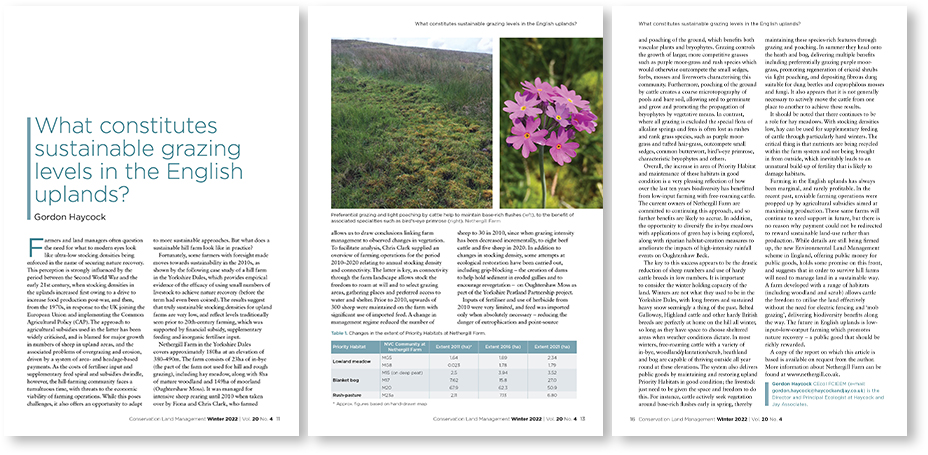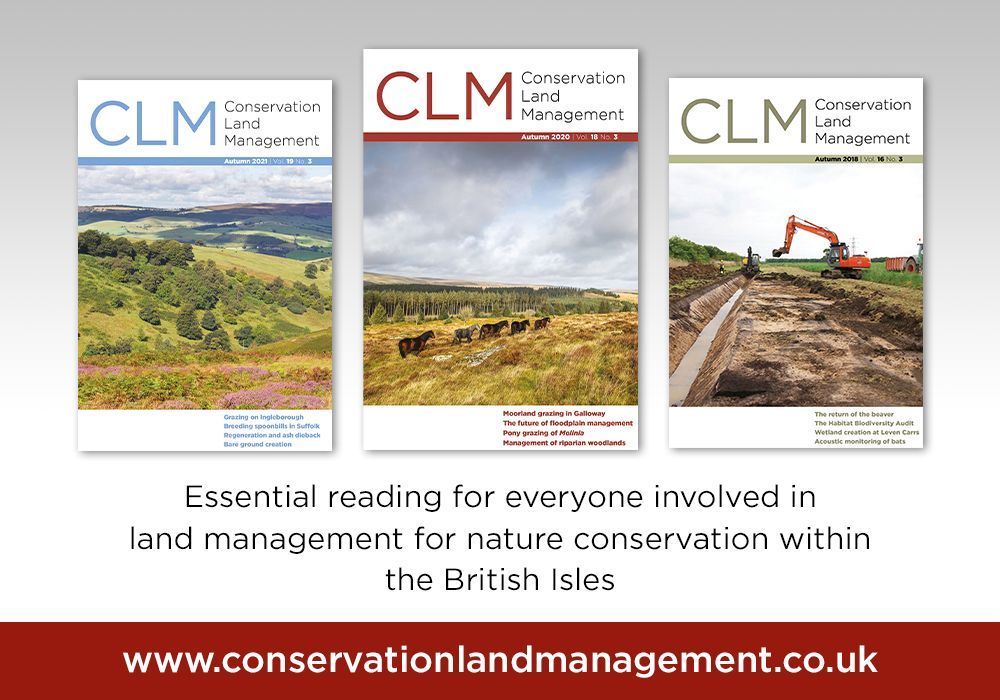The Winter issue of Conservation Land Management magazine (CLM) landed on our readers’ doormats in December, marking the end of volume 20. Read on to discover what featured in the most recent issue, and some highlights of articles across the entire volume.
The Winter 2022 issue of CLM

Reedbed restoration has benefited a large number of species, the bittern being a classic example; by 1997, ‘booming’ (territorial) males of this species had declined to 11, but this has now increased to over 200. Various techniques and machinery are used to manage reedbed habitats, and in this article Graham White and Steve Hughes provide an overview of the different methods and key strategic issues, such as what to do with cuttings, that need to be considered for the future.
Up until 2010, Nethergill Farm, in the Yorkshire Dales, was managed for intensive sheep rearing. Now under new owners, the current management ethos is to promote biodiversity. Gordon Haycock describes how, in addition to other ecological restoration work, a change to reduce sheep stocking densities and introduce free-roaming cattle across the farm has benefited biodiversity and increased the area of Priority Habitats, such as blanket bog and lowland meadow.

In 1965, the Nature Conservation Review was initiated by the Nature Conservancy, with the aim to identify and assess areas important to nature conservation in the UK. In the 1960s/70s, as part of the review, 26 calcareous grasslands in Dorset were surveyed, and in 2018/19, nearly half a century later, six of these were surveyed again. Peter Hawes et al. compare the results of the two surveys, with the aim of determining if the vegetation had markedly changed during the time between surveys, and discuss the gains and losses that have been made.
During the recent political turmoil in the UK, there were rumours that England’s new agri-environment scheme, Environmental Land Management (ELM), would be scrapped in favour of a return to area-based payments. Thankfully, the future of ELM is now looking more certain, but there are still many unanswered questions surrounding the details. In light of this, Alice Groom provides the latest on farming policy development in England, and also in Wales, Northern Ireland and Scotland.
The selection process behind the formal designation of Sites of Special Scientific Interest (SSSIs) in England is based entirely on the compartmentalisation of a site based on the habitat types within it and the rarity of the species found there. Lacking from this process, however, is consideration of habitat connectivity and the ecosystem services that these habitats provide. In the context of two peat bogs in the north of England, one of which is currently threatened by development, Roger Meade asks if the current selection process is up to scratch.
Highlights from volume 20

This volume has included some fantastic articles, from conservation efforts tailored to specific species to wider management approaches and techniques. Below is a selection of articles from 2022:
Spring 20.1
· Habitat translocations: risks, advantages and key considerations – John Box explains the possible risks and potential benefits of habitat translocations, and sets out the key considerations of this approach.
· Conserving breeding goldeneye in Scotland through nestbox construction – Peter Cosgrove et al. share their observations and lessons learnt from constructing and installing nestboxes for the rare goldeneye duck along the River Spey.
· Environmental DNA for ecologists – Dr Helen Rees provides an overview of eDNA analysis and demonstrates how ecologists can use this technique in conservation.
Summer 20.2
· A guide to conservation land management and greenhouse gas emissions – Malcolm Ausden and Rob Field describe how different habitats and their maintenance impact the climate, and highlight the management practices that provide the greatest climate benefits.
· Viewpoint: Dams without beavers: could Beaver Dam Analogues yield benefits in the UK? While we wait for beavers to become more widespread in the UK, Richard Fleming argues that we need to replicate the benefits of natural beaver dams through the use of Beaver Dam Analogues.
Autumn 20.3
· Eleven years of manual eradication of Japanese knotweed – Claire Malone-Lee reflects on 11 years of manual control of Japanese knotweed in Aston’s Eyot nature reserve, in east Oxford, and demonstrates that it is possible, particularly on small sites or where knotweed is not overly dominant, to successfully eradicate this troublesome invasive without the use of herbicides.
· Time to rewet, replant and restore Yorkshire’s peatlands – Jenny Sharman describes the work of the Yorkshire Peatland Partnership and the process of peatland restoration in Yorkshire where signs of recovery have quickly become apparent.

Twenty years of CLM
The end of volume 20 is an important milestone for CLM, marking its 20th year in print. Throughout this time, the magazine has strived to showcase innovative conservation projects, novel management techniques and personal experiences and insights of those working on the ground. Volume 21 is set to feature all of this and more, including a brand new series on habitat management for invertebrates and a look at some of the restoration approaches used in marine conservation.
CLM is published four times a year in March, June, September and December, and is available by subscription only, delivered straight to your door. Subscriptions start from £22 per year. If you would like to read any of these articles, back issues are also available to purchase individually (subject to availability).
If you are involved in a conservation project and think your experiences could be useful to other practitioners, we would love to hear from you. Feel free to contact us if you are interested in writing for CLM – we will be happy to discuss your ideas with you.


